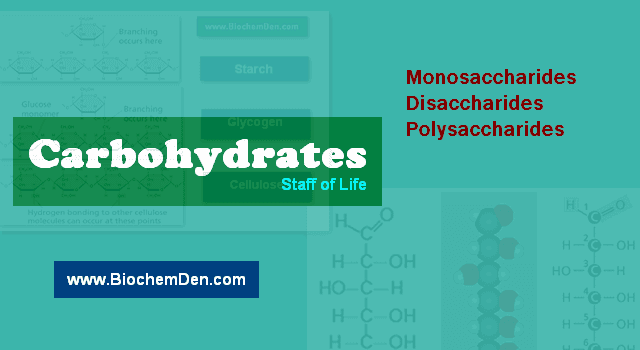Today we are discussing the basic concept of carbohydrate classification from the Biomolecules chapter. Carbohydrates are organic molecules that are composed of the elements carbon, hydrogen, and oxygen.

What is Carbohydrate?
These sugars are referred to as saccharides. Carbohydrates are defined as polyhydroxy-aldehydes or polyhydroxy ketones or compounds that produce them on hydrolysis.
They supply energy and serve as structural constituents.
Carbohydrates have the general formula Cx(H2O)y. They are the ultimate source of most of our food. We dress in cellulose in the form of cotton, linen, and rayon.
We build furniture and houses from cellulose in the form of wood. Let us see the details of carbohydrates and their classification.
Carbohydrates Classification-1
What elements are found in the carbohydrate classification? Carbohydrate classification is explained into three groups based on the number of sugar units and upon their behavior towards hydrolysis.
How are carbohydrates classified? Here is the major classification of carbohydrates: It can be divided into three major categories. They are
- Monosaccharides
- Oligosaccharides and
- Polysaccharides
1. MonoSaccharides
Mono means One, Saccharon implies sugar in Greek. These are the simplest group of carbohydrates and are referred to as “simple sugars” as they are sweet. The compounds have a free aldehyde or ketone group and two or more hydroxyl (-OH) groups. They cannot be further hydrolyzed into simpler compounds. The general formula of the monosaccharide is Cn(H2O)n.
Examples: Glucose and fructose.
Depending upon the total number of carbon atoms in monosaccharides and aldehyde and ketone functional groups present, they are classified using the terms shown in the below table.
| Carbon atoms | General terms | Aldehydes | Ketones |
|---|---|---|---|
| 3 | Triose | Aldotriose | Keto-Triose |
| 4 | Tetrose | Aldotetrose | Ketotetrose |
| 5 | Pentose | AldoPentose | KetoPentose |
| 6 | Hexose | AldoHexose | KetoHexose |
| 7 | Heptose | AldoHeptose | KetoHeptose |
Point: The most abundant monosaccharide in nature is the 6-carbon sugar, D-Glucose.
2. OligoSaccharides
Oligo means “few” in the Greek language. also called oligosaccharides. These are complex sugars. When hydrolyzed, these sugars yield 2 to 10 molecules of the same or different monosaccharide molecules. They are further classified as disaccharides, trisaccharides, tetrasaccharides, etc. based on the number of monosaccharide units.
- Disaccharides (Cn(H2O)n-1) – Sucrose, Maltose, Lactose, Cellulose, Trehalose, Melibiose, and Gentiobiose
- Trisaccharides (Cn(H2O)n-2) – Rhamninose, Gentianose, Raffinose, Rabinose, Melezitose
- Tetrasaccharides (Cn(H2O)n-3) – Stachyose, Scorodose
3. PolySaccharides
These carbohydrates liberate numerous monosaccharide molecules on hydrolysis. They are usually amorphous, insoluble in water, and tasteless, and are called non-sugars.
What are Polysaccharides? They are again subdivided into two types. They are homopolysaccharides and heteropolysaccharides.
Homopolysaccharides
They possess only a single type of monosaccharide unit. Examples: starch, cellulose, and glycogen.
Heteropolysaccharides
They possess two or more types of monosaccharide units. Examples: heparin and chondroitin sulfate.
Important: In the classification of carbohydrates as saccharides glucose is a while starch is a homopolysaccharide and consists of repeating units of glucose molecules.
Carbohydrates Classification-2
Carbohydrates are also classified as reducing and non-reducing sugars. It is a minor classification.
Different types of carbohydrates with examples
1. Reducing Sugars
All those carbohydrates that contain a free aldehyde or ketonic group and reduce Fehling’s solution and Tollen’s reagent are referred to as reducing sugars. Eg: glucose
2. Non-Reducing Sugars
All monosaccharides whether aldose or ketose are reducing sugars.
In disaccharides, if the reducing groups of monosaccharides, i.e., aldehydic or ketonic groups, are bonded, these are non-reducing sugars (e.g., sucrose), while others in which these functional groups are free are reducing sugars (examples: maltose and lactose).
The above carbohydrate classification is a universally accepted classification. If you have any doubts about this, please use the below comment box (or) use the Contact Us form.



